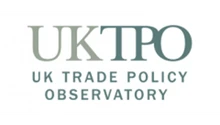Countries that have access to vast amounts of renewable energy – such as Mexico – may be able attract companies to relocate by offering cheaper and cleaner production. But for such ‘powershoring’ to succeed, there needs to be competitive renewable energy capacity and strong trade links.
Geopolitical tensions – from sanctions following Russia’s invasion of Ukraine to tariffs and trade wars – have reshaped global supply chains in recent years. Within this context, access to low-cost renewable energy is increasingly being seen as a key factor influencing decisions about the location of production – a trend known as powershoring.
As countries seek to decarbonise their economies, the availability of renewable energy is becoming an ever more important source of ‘comparative advantage’ (when one country or firm can produce a particular good or service more efficiently than another). But renewable energy potential varies significantly by location, and transporting clean energy over long distances remains extremely costly. For example, converting renewable electricity into green hydrogen (a clean energy source produced by the electrolysis of water) is more than five times more expensive than using the electricity directly at its source.
Given these constraints, relocating energy-intensive industries to regions with abundant renewable resources may prove more economical than attempting to transport clean energy to existing production hubs. This could also bring wider economic benefits to the countries and regions in question, including Mexico.
Where might powershoring succeed?
Powershoring would have the greatest impact on industries where electricity costs represent a significant share of total expenses. Sectors such as chemicals and steel, where energy prices have a strong influence on competitiveness, are already poised for relocation. One survey of 300 industry managers found that 92% expect their company to move their facilities in pursuit of decarbonisation.
Data centres – part of another energy-intensive industry – are already benefiting from Mexico’s expanding renewable energy sector and could drive further relocation trends. The country has 73 new data centres in development, representing an investment of over $8.7 billion.
But moving operations will only be viable if the new location offers competitive costs in other critical areas, such as labour and transport. This makes powershoring a major opportunity for countries that can provide abundant, low-cost renewable energy while remaining competitive in terms of workforce affordability and market access.
In this sense, powershoring currently remains a vision for the future, with most projects still in early or pilot stages. But emerging examples point to its transformative potential. Namibia’s solar-powered green iron facility started production in March 2025; and Chile is planning an $11 billion green ammonia initiative called Volta.
These examples show how countries can leverage renewable energy to enter new industrial sectors and position themselves in a decarbonising global economy. While these efforts face challenges related to infrastructure, financing and regulatory hurdles, they also highlight a strategic opportunity.
One key challenge is the cost of finance. Building renewable energy infrastructure requires substantial upfront capital, making the cost of capital a critical determinant of feasibility.
In countries like Egypt, elevated country risk can significantly raise financing costs, hindering investment in renewable assets. In the short term, so-called blended finance offers a potential solution by leveraging concessional capital to lower investment risk. But over the long term, sound and stable macroeconomic policies are essential to reduce perceived risk and attract more affordable, sustained private investment.
What are the opportunities and challenges for Mexico?
Mexico is well positioned to take advantage of powershoring opportunities given its abundant renewable energy potential and competitiveness in other areas. It ranks in the top 10% of all countries in terms of solar power.
In addition, it has competitive labour costs and low-cost market access to Canada the United States, even considering the tariffs recently set by President Donald Trump. Indeed, the trade policy announcement on 2 April 2025 may actually benefit Mexico, considering that 50% of Mexican exports to the United States are free of tariffs because they are within the United States-Mexico-Canada Agreement (USMCA). The rest of the world will be facing higher tariffs to get access to US markets, and some competitors like China will be facing especially high tariffs on average.
Still, to take full advantage of powershoring opportunities, an active policy that develops dedicated renewable energy resources to this end would be needed. For example, solar power generation costs in Mexico remain high compared with those in many other developed and developing countries. Federal policy could help to decrease these costs, and this should be achievable given that the main cost drivers in Mexico are permitting and inspection costs.
President Claudia Sheinbaum's administration has recently introduced a new energy policy to strengthen the Mexican government's market dominance through the Federal Electricity Commission (CFE). Under the new framework, the CFE will have a minimum 54% share of electricity generation, while the private sector will have a maximum of 46%. The state will also have exclusive control over electricity transmission and distribution.
In the past, the CFE has had problems ensuring that electricity generation keeps up with demand, as well as enabling distribution systems to expand for industrial development. If the operational performance of the CFE does not improve, these reforms pose a serious challenge for tapping into any powershoring opportunities.
The administration has also presented a plan to expand Mexico’s national electric system. Between 2025 and 2030, the target is to add 22.7 gigawatts (GW) of new generation capacity, of which 4.7GW would be solar. In addition to these public investments, the plan expects the private sector to add a further 6.4GW of renewable energy capacity.
While this expansion – particularly in solar energy – represents a significant investment, its scale remains modest compared with the growth of solar energy generation in the United States. The plan anticipates that the new solar plants will be operational by 2027-28. If 4.7GW is deployed by the end of 2027, annual solar capacity additions will average 1,558MW – resulting in a 250% increase from Mexico’s 4,447MW of solar capacity in 2024.
But these investments are not enough to catch up with the solar capacity expansion of the United States or even leading US states. The US Energy Information Administration (EIA) projects that the country will add 32.5GW of solar capacity in 2025. Mexico’s expansion will be a fraction in comparison – representing 37% of solar expansion in Texas during 2023-24 (9% in per capita terms).
Green industrial parks could be one policy tool that would help Mexico to take advantage of its renewable energy potential, irrespective of the overall grid transition at large. These parks should have newly built renewable generation capacity to power their operations. This would enable companies producing within the designated area to certify their production as low carbon and allow Mexico to use its renewable energy potential to its advantage without having to wait until the overall grid has become more decarbonised.
Conclusion
Powershoring presents a long-term opportunity for Mexico, but several challenges must be addressed in order to realise its full potential.
First, the current shifting nature of US trade policy introduces uncertainty about Mexico’s economic growth and the future of the USMCA. This poses a significant risk to industrial development.
Second, certifying the use of 100% renewable electricity remains challenging in a market dominated by the CFE. The CFE controls energy transmission and distribution, and it dominates energy generation too. It does so by using a mix of clean and fossil fuel-based sources. Once electricity enters the grid, it becomes impossible to trace its origin, making it difficult for users connected to the grid to verify whether their power comes from renewable sources.
Third, manufacturing plants must overcome the challenge of energy intermittency. Other countries – including Brazil, Chile and Namibia – are prioritising green industrial development and they plan to invest in future solutions, such as large-scale battery storage or diversifying renewable sources by integrating wind and hydropower storage alongside solar energy.
Lastly, Mexico should make full use of its renewable energy potential by decreasing regulatory costs and developing green industrial parks.
Where can I find out more?
- ‘Powershoring’: Article for the Development Bank of Latin America and the Caribbean by Jorge Arbache.
- Impact of global heterogeneity of renewable energy supply on heavy industrial production and green value chains: Article by Philipp Verpoort, Lukas Gast, Anke Hofmann and Falko Ueckerdt in Nature.
- How decarbonization will transform the geography of industrial production: New evidence on the ‘renewables pull’ hypothesis: Article from the Research Institute for Sustainability.
Who are experts on this question?
- Jorge Arbache
- Laima Eicke
- Philipp Verpoort









































